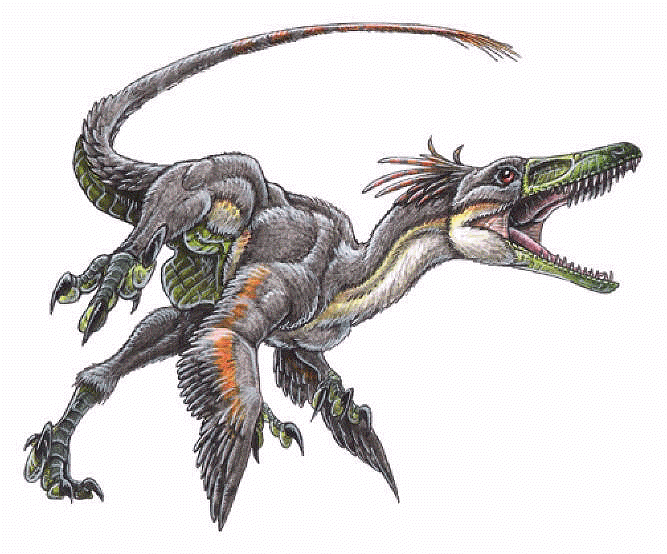|

|
|
Buitreraptor gonzalezorum
(Makovicky, 2005) |
|
 |
|
Name Means: |
Vulture Raptor |
Length: |
2 ft. |
|
Pronounced: |
|
Weight: |
|
|
When it lived: |
90 MYA |
|
|
|
Where found: |
Argentina |
|
|
|
Buitreraptor gonzalezorum
was a rooster-size predatory dinosaur belonging to the dromaeosaurid
family. It was found in Argentina and was described in 2005.Buitreraptor
gonzalezorum is the only known species of the genus
Buitreraptor. The genus name means "Vulture-raptor," from the
Spanish word buitre meaning vulture.
Buitreraptor lived about 90 million years ago, when South
America was an isolated continent like Australia today.
Buitreraptor has some different physical features than typical
northern dromaeosaurs, like Velociraptor. Buitreraptor
has a slender snout with teeth that lack meat-tearing serrations. From
this scientists conclude that this dinosaur was not a big-game hunter
like most other dromaeosaurs, but a hunter of small animals such as
lizards and mammals. Its long bird-like arms confirm such a life of
grasping fast-moving small prey. It has long legs and must have been
an agile runner. It most likely had feathers. This dromaeosaur
occupied a niche like that of modern secretarybirds or even the
dinosaur Troodon from North America.
Other than Buitreraptor, the only other known dromaeosaurs
from the southern continents are Neuquenraptor and Unenlagia
from South America (discovered earlier in 2005), Rahonavis
(once thought to be a true avian bird) from Madagascar, and
unidentified dromaeosaur-like teeth from Australia. The bones in both
Buitreraptor and Rahonavis show either that powered
flight evolved independently in two different groups of dinosaurs:
birds and southern dromaeosaurs, or that flight evolved once in the
ancestor of dromaeosaurs, and subsequently the two dromaeosaur lines
(northern and southern) became secondarily flightless.
This discovery in the Southern Hemisphere confirms that
dinosaurs were more widely dispersed around the world than previously
thought. Scientists now think that dromaeosaurs date back to Jurassic
times, when all the continents were much closer together. It is
possible that they originated on the ancient continent Laurasia in the
north, and migrated to southern Gondwana later.
The fossilized bones were found in 2005 in sandstone in
Patagonia, Argentina - by an excavation lead by Peter Makovicky,
curator of dinosaurs at the Field Museum in Chicago). Buitreraptor was
discovered in the same fossil site that had earlier yielded
Giganotosaurus, the biggest carnivorous dinosaur known to science
since 1995.
-
The new discovery, named Buitreraptor, provides
definitive evidence that dromaeosaurs also lived in South America -
part of Gondwana. They must have originated when all of the continents
were still assembled in a single landmass - during the Jurassic. When
the landmass split in two, the dromaeosaurs diverged into northern and
southern groups. Analysis by the authors of the Nature paper show
Buitreraptor and Rahonavis, a fossil animal from Madagascar
previously considered a primitive bird, form a southern branch of the
dromaeosaur family tree. This branch is distinct from Laurasian
dromaeosaurids, including Velociraptor and some of the famous
feathered dinosaurs from China. Birds are commonly thought to have
evolved from this group. The authors say the discovery Rahonavis
and Buitreraptor have long and wing-like forelimbs could imply
that flight evolved twice, once in birds and once among this group of
Gondwanan dromaeosaurs. The specimen will be on show at
the Chicago Field Museum's Evolving Planet exhibition that opens in
March. |
|
|
|
|
|
|
|
|
Edugraphics.Net | Feenixx Publishing |
|
|
|
|
|
![]()
